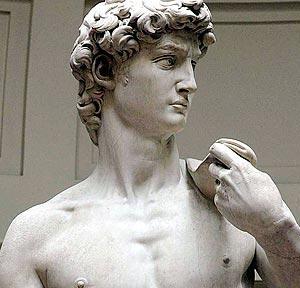Michelangelo's statue of David must be stabilised because it risks falling over due to an accumulation of small shocks, an expert warned on Friday.
Antonio Borri, a structural engineering professor at Perugia university, told a conference that the statue's weight, pose and poor-quality marble meant it was exposed to the risk of toppling.
Borri said the monumental work in the Accademia Gallery could come down ''not only if an earthquake hits but also because of continual environmental stressors such as building work or pneumatic drills in the street outside''.
Proof of the effect of constant vibration was the fact that cracks in the work which were plastered over four years ago had ''all already resurfaced''.
However, Borri stressed that Florence's most famous statue - a copy of which stands outside Palazzo Vecchio - was not in danger of imminent collapse, except in the unlikely event of a major earthquake.
However, recent tests have shown the statue would be damaged even in the event of a light tremor.
Florence has a recorded history of 127 minor quakes, none of which topped five on the Richter scale.
In the past it has been suggested the the David should be moved to an earthquake-proof underground room to protect it from seismic activity.
More recently, there has been a bid to move it to a purpose-built site outside the city centre to relieve traffic congestion.
Authorities have long been concerned about the stability of the statue, whose ankles are allegedly too thin to support its 5,572 kilograms safely.
The visible cracks covered up in 2004 were mostly in the left ankle and in the carved tree stump which bears part of the statue's weight.
The cracks in the statue's ankles are believed to have developed because it spent over a century leaning forward dangerously as it stood in the main city square.
Work is currently under way on special equipment able to produce a CAT scan of the statue, which would be used to locate invisible fractures in the marble.
In 1873, after 469 years in the elements during which time its surface became rough and pockmarked, the David was taken out of the elements and put in the Galleria dell'Accademia.
A copy was erected on its original site - where some of Florence's visitors take it for the real thing.
The statue was conceived by the Florentine governors who commissioned it as an emblem of the city's pride and its ability, despite its small size, to defend itself against giants.
Michelangelo chiselled the marble for three years and eventually created what came to represent the Renaissance ideal of manhood. It was unveiled in Piazza della Signoria in 1504.





